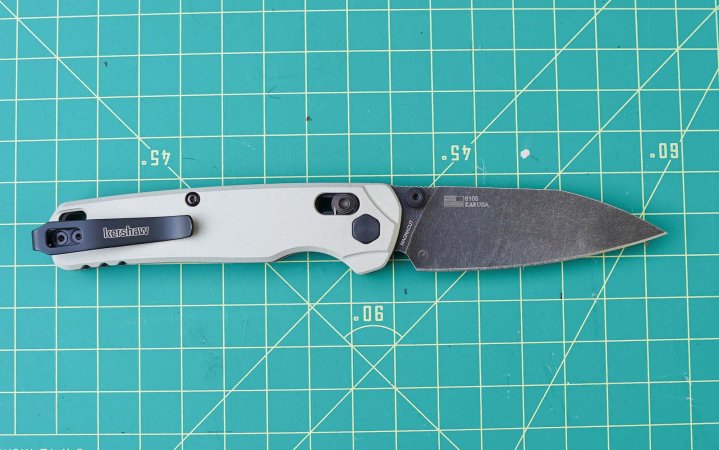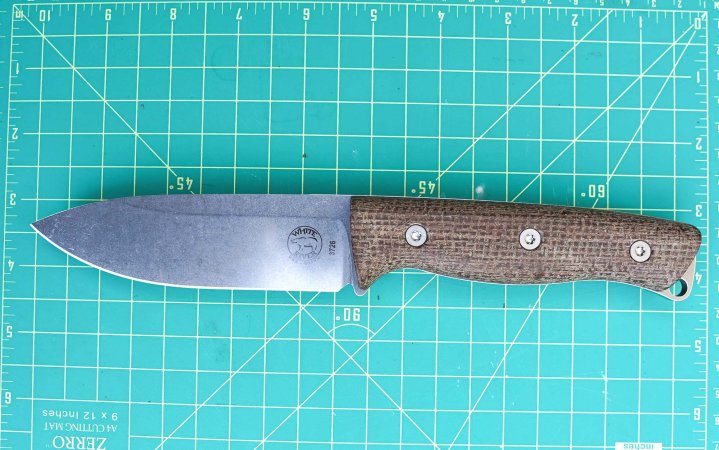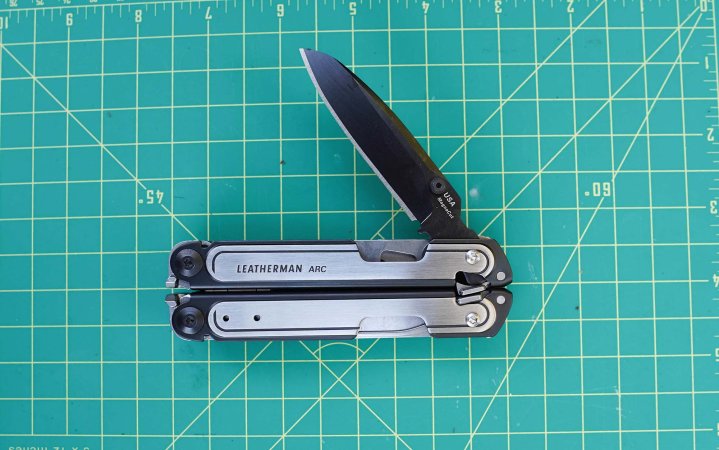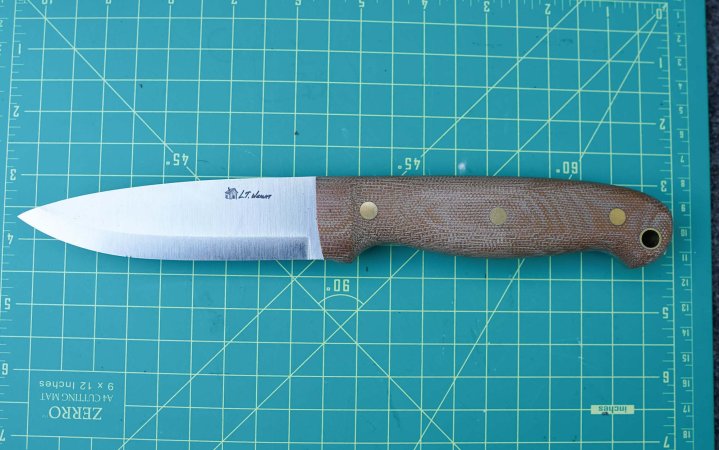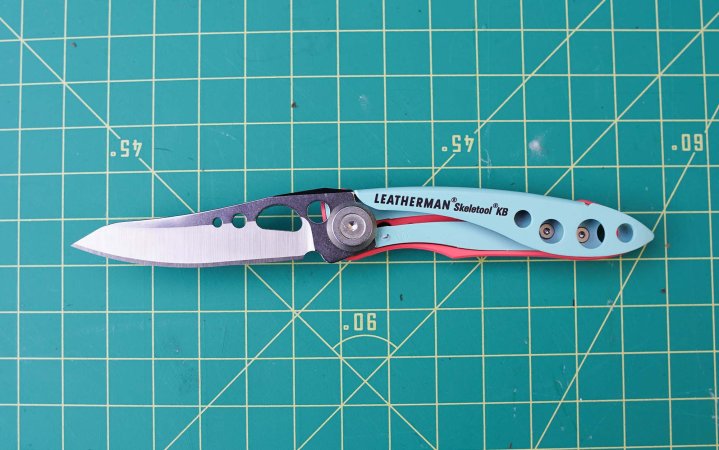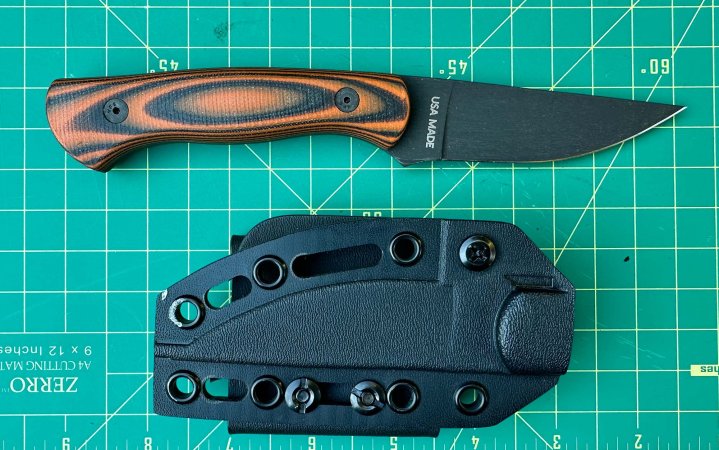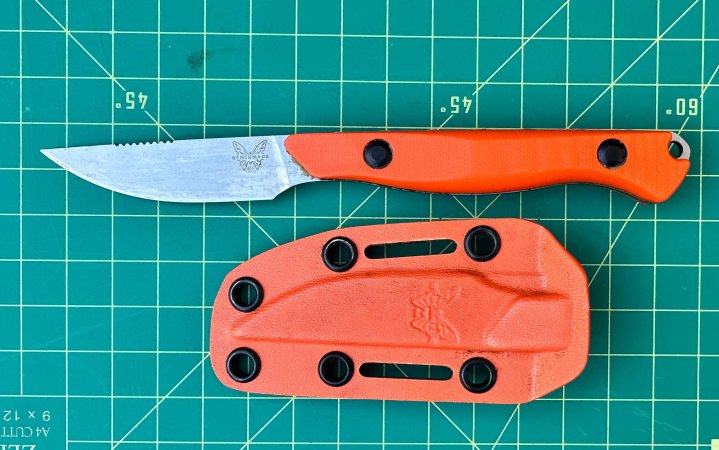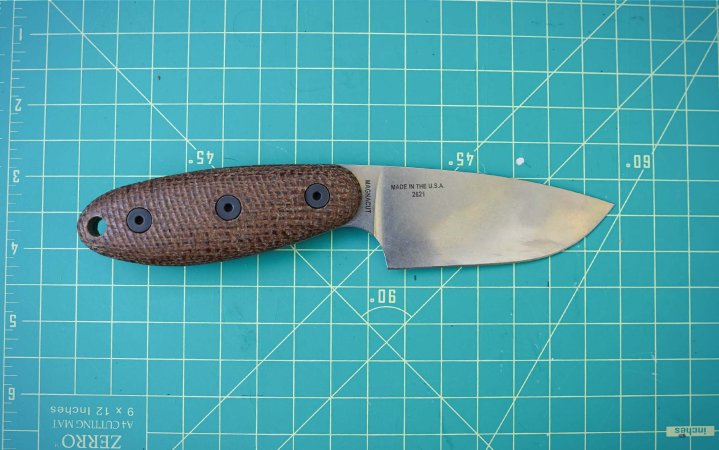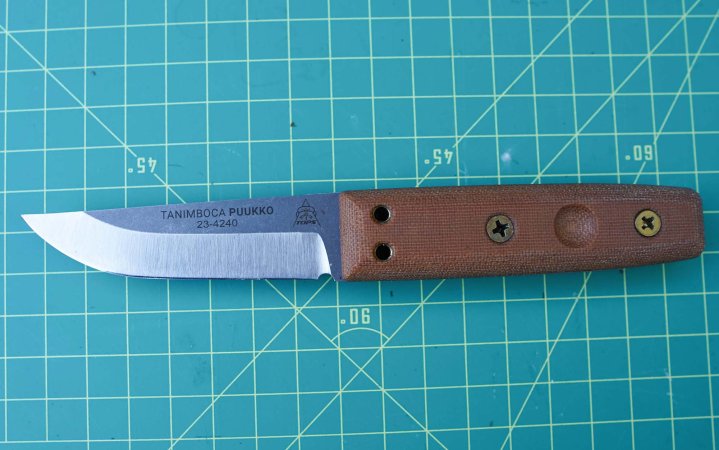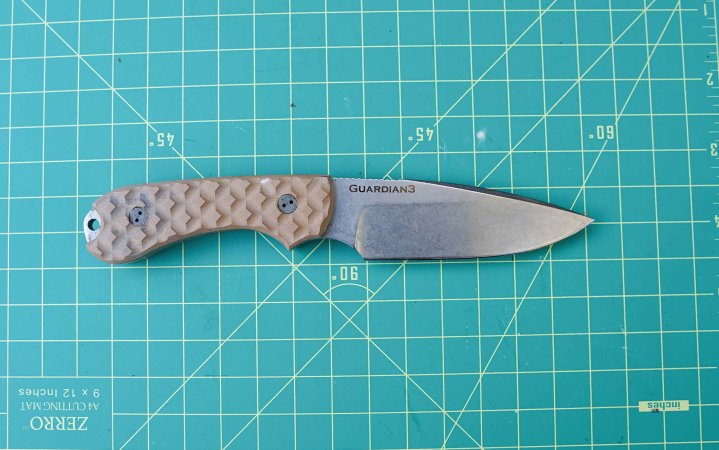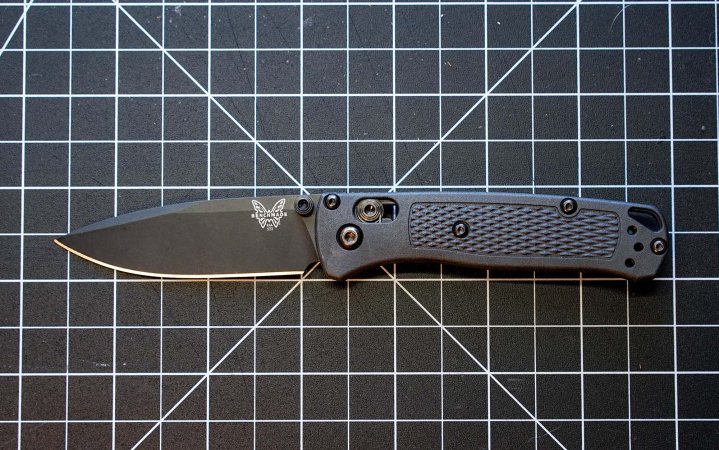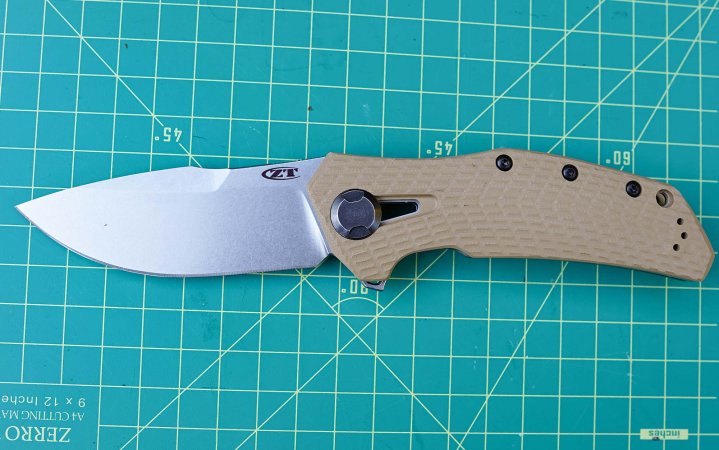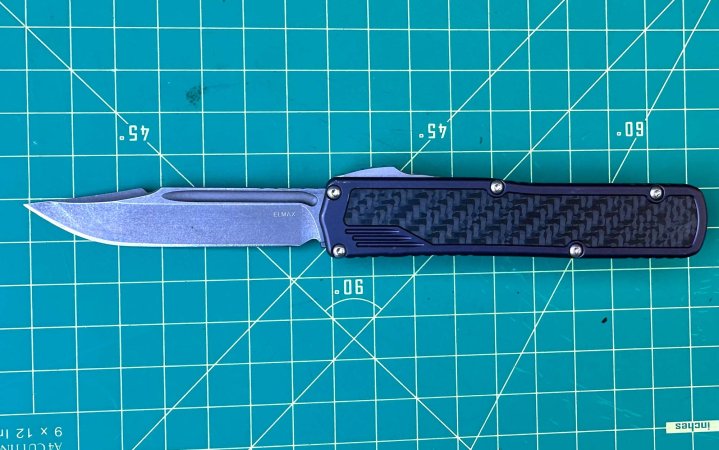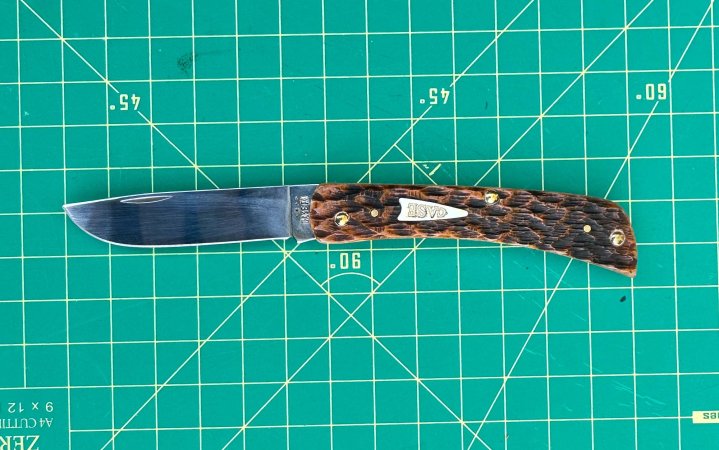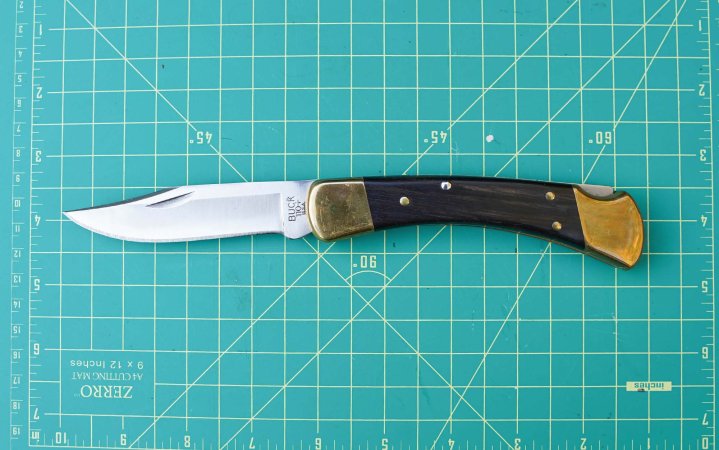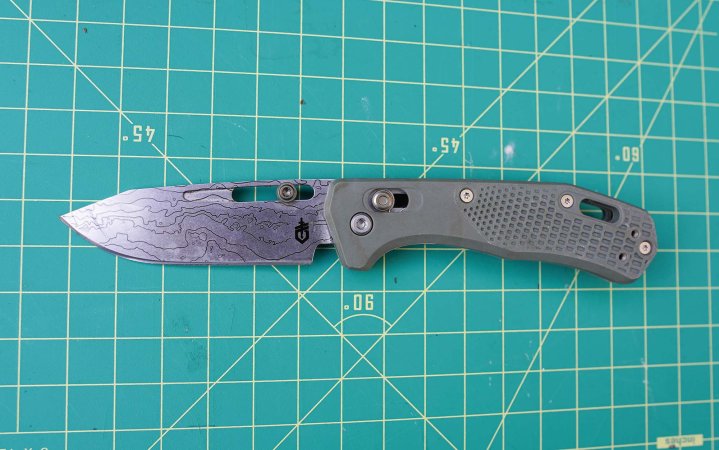We may earn revenue from the products available on this page and participate in affiliate programs. Learn More ›
There are a lot of great knives being made in Poland, South Africa, France, Russia, Japan, and, yes, China. But, hand on a bible, I believe the very best knives are still being made in the United States.
There are a few reasons the U.S. comes out on top: a large market that demands quality blades, access to excellent raw materials, a plethora of custom knife makers, a variety of machine shops, and big businesses that are turning out the good stuff at a variety of price points. And for the most part, American companies have great warranties and it’s easier to get a repair or replacement than dealing with a company based overseas.
That’s not to say our home-grown knife companies aren’t without their faults or don’t occasionally turn out lemons. It’s totally fair to criticize certain brands for poor quality control or insane pricing. I will highlight those low points when appropriate in my reviews below.
Of course you might choose to buy a knife made on home soil for the same reason you fly the stars and stripes on your front porch and cheer after the national anthem plays — you’re a patriot. You live in the United States and want to support companies that create jobs for your fellow countrymen.
I’ve ended up with a large collection of USA made knives for all the reasons above. If you’re looking to start or expand your knife collection, here are my picks for the best USA-made knives based on testing and my personal preferences.
Best of the Best
Best Fixed Blades
Best Folders
Choosing the Best USA Made Knives
I’ve tested over a hundred knives, but there are still thousands I haven’t cut with. The knives that made my list are all standouts from previous tests, have been in my collection for years, or are top performers in ongoing testing. Consider this list to be a great starting point if you are looking for a new knife as it will introduce you to top brands. I’ve also included honorable mentions for knife brands that are worth considering, but I haven’t yet tested.
I’d also like to note that some of the knives in this article were sent to me by companies for the purposes of testing and reviewing, but the vast majority of the knives represented were purchased by me for my own use. It doesn’t matter if I buy something or it was sent in for review, I look at it objectively and give you my honest thoughts.
Read Next: Why Don’t More Hunting Companies Manufacture Camo in the United States?
Best of the Best Knives Made in the USA
I’ve been collecting knives for more than 10 years and there are a rare few knives that are the upper crust of my collection. These five knives are ones that I enjoy using every time they are on my belt or in my pocket. I’ll never sell any of them.
Best EDC: Kershaw Bel Air
Key Features
- KVT ball bearings
- Lock Type: DuraLock
- Pocket Clip: Reversible deep-carry (right/left, tip-up)
- Warranty: Limited lifetime warranty
- Blade Length 3.1 inches
- Blade Material: CPM MagnaCut
- HRC: 62 to 64
- Blade Finish/Coating: BlackWash
- Blade Thickness: 0.09 inches
- Closed Length 4.2 inches
- Handle Material: 6061-T6 aluminum
- Handle Finish/Coating: Cerakote
- Handle Thickness: 0.44 inches
- Overall Length: 7.3 inches
- Weight: 2.9 ounces
- Price: $150
My first impressions of the Bel Air set a high bar. When I took the Bel Air out of its box, I flicked it open and experienced one of the best crossbar lock actions I’ve handled. The quality build is immediately evident and with a Mangnacut blade, it’s offered at a great price ($160).

A look at the Bel Air’s action and cutting ability.
The Bel Air truly impressed me when I tested it head to head against the WE Banter — one of my favorite EDC blades. The Banter has a slightly better action, but the Bel Air cuts circles around the Banter. Its blade flew through cardboard, dug deep into wood, and breezed through various cordage.
Of all the USA-made knives I’ve tested this year, the Bel Air is the most refreshing. A lot of companies are taking serious flack for pricing their knives way too high. Yet, here is a knife that’s priced very fairly for its materials, performance, and country of origin. I’m safely calling this the best value in American made knives and a great buy for anyone looking for a quality pocket knife. The only criticism I have for this knife is a lack of traction on the aluminum scales.
Read Next: Best EDC Knives
Best for Collectors: OZ Machine Company Roosevelt
Key Features
- Blade Length: 2.9 inches
- Over Length: 7 inches
- Weight: 2.9 ounces
- Blade Thickness: 0.375 inch thick
- Hardware and scales made from grade 5 titanium (including screws)
- 10 ball ceramic bearings in Delrin cages
- AEB-L lock insert with two ceramic detent balls
- CPM MagnaCut Blade (63 to 64 HRC)
- All components made by Oz Machine Co.
- Price: Starting at $700
At a certain point a knife is just a knife. If you keep it sharp it’ll perform normal cutting tasks well. But some knives are more than just a cutting tool. They are a source of daily happiness and an extension of the person carrying them.

A look at the Roosevelt’s action.
The latter is the world where the OZ Machine Company Roosevelt (Rosie) exists. The basic function of cutting is of course important, but people who are excited to spend $800 on a knife want more than a razor blade. They want impeccable machine work, exciting design, and an action that’s supremely satisfying. The Rosie delivers all of this at a very high level. It’s also thoughtfully designed for carry and daily use. It’s shockingly light and thin, yet perfectly comfortable while cutting. One of the reasons why the Roosevelt is such a high quality folder is that every component is made in house, including the screws and bearings. Add in tight tolerances and strict quality control and you end up with a knife that is, in a word, perfect.
The main negative of the OZ Rosie is its availability. It took me nearly a year of trying to get one and they aren’t getting easier to find. OZ simply can’t make enough to satisfy the demand, which causes crazy secondary market prices. The hunt for one of these coveted knives is frustrating, but it’s also part of the fun and it’s a signal that there is serious demand for knives at the pinnacle of quality. If you want one of these knives I recommend signing up for email alerts, following Oz Machine Co on social media, going to knife shows that Oz Machine Co attends, and keeping an eye on R/Knife_Swap.
Best Camp Knife: White River Ursus 45
Key Features
- Weight: 8.3 ounces
- Blade Length: 4.5 inches
- Overall Length: 9.5 inches
- Blade Thickness: 0.158 inch
- CPM S35VN Steel (HRC 58-60) or CPM MagnaCut (HRC 62-64)
- Kydex Sheath
- Includes matching ferro rod
- Micarta handles
- Price: $250 (S35) or $270 (MagnaCut)
A camp knife is the ultimate jack of all trades and master of none. It needs to process kindling, start fires, do food prep, whittle roasting sticks, make tent stakes, and handle some basic bushcrafting. It’s hard enough finding a quality blade that excels at a few of those tasks, let alone all of them. Yet the Ursus 45 does it all, plus it has a 90-degree spine that throws a cascade of sparks from a ferro rod, it’s nicely finished, and it comes with a great sheath.

Mine is in CPM S35VN, but it’s also available in Magnacut. The blade shape and grind are what makes this knife so capable. It has a high saber grind on a fairly wide blade, which keeps it slicey, while still being durable enough to baton wood. The spearpoint/drop point blade excels at nearly everything and I don’t miss the belly it sacrifices over a knife with less drop. Another note is that the handle isn’t overly shaped so that it doesn’t force you into holding the knife int a certain way. It’s comfortable in a wide variety of grips and can be used for hours without fatigue.
Best Multi-Tool: Leatherman Arc
Key Features
- Main Tools: MagnaCut knife, pliers, bit driver, diamond-coated file, small bit driver, wood/metal file, pry tool, screwdriver, bottle opener, can opener, awl, scissors, and saw
- Weight: 8.6 ounces
- Closed Length: 4.25 inches
- Primary Blade Length: 2.76 inches
- Blade Hardness: 60-63 HRC
- Width: 1.3 inches
- Overall Thickness: 0.68 inch
- Materials: 420 Stainless Steel, 440C Stainless Steel, DLC Coating, MagnaCut Steel, PVD Coating
- Included Bits: Torx #10 & #15, Torx #20 & #25, Screwdriver 3/32″ & 1/8″, Pozi #2 & #1, Hex 1.5mm & 2mm, Hex 2.5mm & 3mm, Hex 4mm & 5mm, Robertson #1 & 2, Robertson #2 & 3
- Tools lock into place
- Price: $230
I’m a fan of the show Alone and think there’s a lot to learn from watching people’s experiences on the show. One interesting take away is that seven of the 11 Alone winners have chosen to take a Leatherman multi-tool over a fixed blade knife as one of their 10 items. The Leatherman Free, Surge, and Wave have all been used on the show. The new Arc takes many of the best qualities of those multi tools and adds in a MagnaCut blade. I’ll hopefully never have to use it to survive 90 days in the wilderness, but I do use my Arc to solve problems daily. The Arc can be opened with one hand and all 10 tools deploy easily. I like that they’re all highly useful tools and there’s no fluff, so you’re not carrying around something you’ll never use.
Read Next: Best Multi Tools
Best for Bushcraft: LT Wright GNS Scandi MagnaCut
Key Features
- Overall Length: 9.5 inches
- Blade Length: 4.5 inches
- Blade Thickness: 0.125 inches
- Handle Length: 5 inches
- Handle Material: Micarta
- Weight: 8.3 ounces
- Comes with leather sheath with dangler and ferro rod loop
- Price: $345

I’ve used a lot of scandi knives and I’m currently testing several head to head. Nothing has come close to the LT Wright’s ability to carve wood. I recently used it to do the bulk of carving a pocket spoon and it cut clean, controlled ribbons of wood. It didn’t matter if I was removing a lot of wood while shaping or removing nearly translucent slivers, the GNS provided the control and feedback I needed. Most true scandi grinds are good at carving, but this LT Wright is a step above others I’ve used. I think they’ve hit the right combination of grind angle, stock thickness, and exceptional out-of-the-box sharpness. It’s also an exceptionally well made knife and it comes with a great sheath. It does all the bushcraft things well like batoning, drilling, and it throws sparks off a ferro rod.
Read Next: Best Bushscraft Knives
Best Bargain: Leatherman Skeletool KB
Key Features
- Weight: 1.3 ounces
- Closed Length: 3.45 inches
- Open Length: 5.87 inches
- Primary Blade Length: 2.6 inches
- Width: 0.8 inch
- Overall Thickness: 0.3 inch
- Blade Material: 420HC stainless steel
- Price: $40
There are only a few options for USA made knives under $50. But the Leatherman Skeletool KB is $40 and pretty darn useful. I’d compare it to the inexplicably popular Gerber Paraframe in terms of size, materials, and performance — the Paraframe is made in China though. The knife blade does light EDC tasks well and in typical Leatherman fashion, it’s more than just a knife thanks to the integrated bottle opener. Now, the Skeletool KB is not a hard-use knife or anything that will make a collector swoon, but it gets the job done at minimal cost.
Other excellent budget blades to consider are the Kershaw Leek ($61) and Buck 110 Slim ($40).
Best Fixed Blade Knives Made in the USA
Key Features
- Blade Steel: 52100 Ball Bearing Steel or MagnaCut
- Overall Length: 7.5 inches
- Blade Length: 3 inches
- Blade Thickness: .110 inch
- Weight: 3.6 ounces
- Handle Material: G-10
- Includes Kydex sheath
- Price: $300
There is a lot of hype in the knife world and it’s easy to get turned off by it. MKC is a company that rode a tidal wave of hype to success, but based on my testing of several of their knives, they earned that praise — mainly due to their designs and build quality.
My favorite MKC hunting knife is the Blackfoot 2.0. Its sculpted G10 handle is comfortable in a variety of grips and you can spend hours using the knife without fatigue. The drop point blade is deceptively simple. It has a comfortable choke up point and a thin grind for precision cutting. It also has the perfect balance of belly, point, and straight cutting edge to process game of all sizes and take on general cutting tasks.
As much as I think MKC has earned their hype, they’ve also earned the some of the accompanying criticisms. Their knives are priced on the higher-end of the value spectrum. Despite the higher prices, they still sell out on every drop, so the market seems to think the prices are fair.
Read Next: Best Hunting Knives
Best Birds and Small Game: Benchmade Flyway
Key Features
- Length: 6.96 inches
- Blade Length: 2.7 inches
- Blade Thickness: 0.09 inch
- G10 handle
- Weight: 2.1 ounces
- Blade Steel: CPM154 (58-61HRC)
- Price: $260

My love for the Benchmade Flyway runs deep. It’s like a scalpel and a tough-hunting knife came together to become the perfect precision animal processing tool. I’ve used it on deer, pheasant, and quail with superb results. If I wasn’t committed to testing a variety of knives, I’d be happy with the Flyway or the Blackfoot being my only hunting knives. Whether I’m cutting along a breast bone to greedily remove every scrap of meat or caping out an elk, they would be my first choice. Which is better? The Flyway wins out in packability and precision. The Blackfoot wins out for all-around utility.
Best EDC: ESEE Sencillo
Key Features
- Overall Length: 7.25 inches
- Edge Length: 3.25 inches
- Blade Thickness: 1/8 inch
- Blade Material: A2 Steel or MagnaCut
- Full flat grind
- Tumbled blade finish
- 3D Burlap Micarta handle
- Kydex sheath included
- Price: $160 to $175

EDC fixed blades are hot right now, and one of the best USA-made options is the ESEE Sencillo. There are four reasons why I like it: MagnaCut, ESEE’s unconditional lifetime warranty, idyllic ergonomics, a blade shape that tackles everyday cutting tasks, and it’s priced very reasonably at around $170. In my testing so far, the blade is a great slicer while breaking down boxes, doing food prep, and processing game. The sheath it comes with is OK for belt carry, but I’d get an aftermarket sheath for pocket carry.
Best Companion: Tops Knives Tanimboca Puukko
Key Features
- Blade Material: 1095 carbon steel (HRC 56-58 steel)
- Blade Length: 3.63 inches
- Overall Length: 7.75 inches
- Micarta handle
- Includes leather sheath with belt loop
- Price: $140
Puukkos are the knives to get if you want to carve wood all day, but they aren’t ideal for hard-use tasks or more general outdoors jobs. The Tanimboca fills the gap between a traditional puukko and heavy-duty fixed blade. It carves well, it has flexible ergonomics to take on a wide range of tasks, and its secondary bevel adds strength to its thin grind. This is a great knife to pair with an ax or larger fixed blade if you’re bushcrafting or camping.
Best Small: Bradford Guardian 3
Key Features
- Available in a variety of handle and blade materials
- Includes leather scout carry sheath
- Blade Length: 3.5 inches
- Overall Length: 6.75 inches
- Weight: 3.4 ounces
The Bradford Guardian has been around for a long time and it’s still one of the best deals in a USA made fixed blade. They cost from $115 to $200 depending on the materials, and they all carry the same great design. I’ve used mine for EDC and hunting with no complaints other than the sheath could be improved.
Read Next: Best Fixed Blade Knives
Honorable Mentions
These are companies that make great knives that I haven’t yet tested.
Best Folders Made in the USA
Best Lightweight: Benchmade Mini Bugout
Key Features
- Blade Length: 2.82 inches
- Overall Length: 6.49 inches
- Weight: 1.5 ounces
- Blade Steel: S30V
- Deployment Method: Thumb stud
- Grivory handle
- Axis Lock
- Price: $180
I know Benchmade isn’t Reddit’s favorite knife brand, but let’s put aside the recreational rage and look at the Bugout objectively. The Bugout remains one of the best designs for an EDC knife. Its simple, yet effective design is timeless and just plain works. I like the standard Mini Bugout with Grivory scales and S30V blade. A lot of knife reviewers have said you’ll “forget you’re carrying it” about an assortment of knives, but the Mini Bugout really is so incredibly light that you don’t notice it. Whether or not they’re a great value is totally up to the end user to decide.
Best Slicer: Spyderco Manix 2
Key Features
- Overall Length: 8 inches
- Blade Length: 3.37 inches
- Steel: CTS BD1N or S30V
- Closed Length: 4.66 inches
- Weight: 2.9 ounces
- Blade Thickness: 0.125 inch
- Handle: FRCP
- Full flat grind
- Price: $160 to $200
I could have chosen a half dozen Spydercos to take the title of best slicer, but the Manix stands out among them for several reasons. It has a solid locking mechanism, its blade is thin— yet not too thin — and it has the best ergonomics of Spyderco’s elite slicers. Spyderco has also been accused of finding the limits of what consumers are willing to pay for a knife, but the Manix 2 is fairly priced at around $160.
Best Hard Use: Zero Tolerance 0308
Key Features
- CPM 20CV blade steel (HRC 60–62)
- KVT ball-bearing
- Titanium framelock with hardened steel lockbar insert
- Pocketclip: Reversible
- Blade Length: 3.75 inches
- Blade Thickness: 0.156 inch
- Closed Length: 5.2 inches
- Handle Material: G10 front, titanium back
- Price: $251

A look at the ZT 0308’s action. Turn the sound on to hear the blade lock into place and the detent snap the blade back in.
Zero Tolerance was one of the first brands that I went nuts over. The ZT 0308 captures the spirit of the over-built knives that first grabbed my attention. It’s a big knife, but the action is dialed perfectly and it fires out the 3.75-inch blade with authority. It’s so much fun to hit the flipper tab and feel the giant blade lock into place. It has a comfortable thumb ramp with grippy jimping that doesn’t bite you back. With your thumb placed there you can put a lot of power into your cuts and do so without developing a hot spot. I might still be in the honeymoon phase with my 0308, but it’s one of the more exciting folders that I’ve got this year and I’m loving carrying it.
Best EDC OTF: Guardian Tactical Scout
Key Features
- Overall Length: 8 inches
- Blade Length: 3.45 inches
- Blade Material: Elmax
- Hollow grind
- Closed Length: 4.5 inches
- Price: $395
I always thought OTFs were cool, but when my Halo V became a glorified letter opener, it was proof that I didn’t quite see their utility. That was until I got my Guardian Tactical last year. This slim double action OTF is easy to carry and it opened my eyes to how practical this knife design is. You can pull the knife from your pocket, shoot the blade out, make a cut, and have it back in your pocket in seconds. It’s so much faster and efficient than a typical folding knife or even a side opening auto.

A look a the Scout’s action.
The knife itself is well made with minimal blade play, a snappy action, and you can fidget with it without getting tired. I especially like the design of the switch which gives you proper leverage while being ergonomic. The carbon fiber inlay adds class and it doesn’t have the aggressive look of more tactical OTFs.
It’s worth mentioning that there are a lot of excellent OTFs made in America. The Microtech Ultratech, Benchmade Shootout, and Kershaw Livewire are all great knives and which you choose is ultimately a matter of personal preference.
Best Value Slipjoint: Case Sodbuster Jr.
Key Features
- Blade Length: 2.8 inches
- Weight: 2 ounces
- Price: $66
If you’re just getting into slipjoints, I’d skip trying to hunt down a GEC or spending big bucks on a Jack Wolf. Instead, get a Case Sodbuster variant that you like the looks of. Case does some of the best jigged bone, especially for the price, and the sodbuster pattern is perfect for putting to work. At around $66 they’re a good value, but I do recommend ordering from a retailer with a good return policy in case you get a lemon.
Best Lockback: Buck 110
Key Features
- 3.75-inch blade
- 420HC stainless steel blade
- Lockback
- Closed Length: 4 7/8 inches
- Weight 7.2 ounces
- Price: $65
American knife brands are a lot like family members. They might do things that annoy you, upset you, or embarrass you, but in the end they’re family and all is forgiven. Buck is definitely kin, which is why the 110 is on this list. While I think the 110 is an iconic design, the build quality on the ones I’ve bought lately haven’t been the best. I’ve ordered several over the last few years and had to return them for poor centering and uneven grinds. I’ll always own a few Buck 110s because they cut well and I really like their traditional look. The updated 110 models are also worth looking at if you like a more modern design.
Best Customizable: Gerber Assert
Key Features
- Blade Length: 2.98 inches
- Steel: S30V
- Weight: 1.87 ounces
- Lock: Pivot Lock
- Customizable blade, handle, and hardware
- Price: $175
With some knives, the color scheme is predetermined at the factory and you either like it or you don’t. But, the Gerber Assert is customizable in that you can choose the blade finish, hardware color, and handle color. I went with the topographic, stonewashed blade, a green handle, and orange back spacers. The process was fun and easy execute on the Gerber site. They sent me my customized knife a few weeks later (custom orders take 12 to 15 days to ship).
The Assert is a comfortable knife to carry and it’s the sort of blade that disappears in your pocket thanks to its size, deep carry clip, and minimal weight. You can one hand deploy the Assert with the adjustable thumb stud or the fuller. While it doesn’t fire open like some of the best flippers on the market, if you use your knife as a tool, rather than a fidget spinner, you’ll be happy with the action.
Read Next: Best Pocket Knives
Premium Folders

Scott Einsmann
Best Action: Brown Knives Mini FSD-I
If you want an expensive folding knife with instantly recognizable quality, the FSD-I is your knife. It looks and feels high end without being gaudy. The action is the best I’ve experienced and it goes beyond being just smooth — it’s a controlled, hydraulic type smoothness. The detent is just strong enough for the blade to fire out with a reverse flick or the front flipper, but it’s not so strong that you can’t smoothly roll out the knife with your thumb. The machine work is impeccable and there are a lot of neat machining Easter eggs to find. As pretty as the knife is, it’s still a tool and it cuts very well thanks to its hollow grind.
Best Pivot System: Hinderer XM-18
The XM-18 is my favorite premium, overbuilt folder and I think it lives up to the hype. For EDC the 3-inch, non-flipper variant would be my top choice. I carry the 3.5-inch non-flipper, which is also a great choice if you don’t mind its size. The genius of the XM-18 is in the Tri-Way pivot, which allows you to swap between bearings, bronze phosphor washers, or Teflon washers. So if you want a rugged knife that’s easy to clean you can run washers or if you want the silky smoothness of bearings you can easily swap to those. Hinderer knives also have a lot of aftermarket support with custom scales, screws, pocket clips, and pivots so you can customize your knife.
Best Flipper: Koenig Arius
The Arius is like the FSD in that it looks and feels like a quality knife. The flipper action is insanely good, but it’s kind of a one trick pony. My knife’s detent is a little too strong for a reliable reverse flick and it doesn’t roll out for the same reason. The pocket clip on mine is also too tight and I can’t fully clip it onto jeans. Yet, it’s still one of my favorite knives because of the deep hollow grind, great looks, comfortable ergonomics, and fun flipper action.
Best Slipjoint: GEC and Northwoods

GEC makes the best USA-made production slipjoints. They have a huge catalog of patterns that they release throughout the year and all of them are highly sought after by collectors. The demand for GEC slip joints is so high that they’re extremely difficult to buy. Northwoods is an even harder-to-get brand made by GEC. If you’re really interested in picking one up here’s what you need to know:
- Check greateasterncutlery.net for what’s currently in production
- It usually takes two weeks to a month for knives to go from in production to available
- Sign up for email alerts from KnivesShipFree (they’re usually the first to get GEC and Northwoods)
- When a drop happens, buy your knife quickly because they’ll sell out in minutes
Honorable Mentions
Just like the fixed blades there are some great USA-made folders that I still haven’t tested. Here are a few worth checking out.
The UpShot
U.S. manufacturers have a lot of competition — mainly from China. The PRC is producing quality budget knives and knives up to the $300 range with great materials and designs. In terms of value, Chinese-made knives beat American-made knives in most cases.
What’s driving the quality of overseas knives is one of the biggest trends in the knife world: OEM manufacturing. There are a lot of talented knife designers who are having Chinese companies build their designs, rather than spending millions on creating their own manufacturing facility here in the U.S. This allows a designer to come to market quickly and cheaply. A few examples of this are Vero Engineering, Knafs, and Null Knives. One of the most innovative knife brands is Winter Blade, which is driven by a U.S. designer who developed a completely new method of knife deployment using magnets. The knives are incredibly popular and they’re made in China.
While China is winning with value, the U.S. dominates a few key categories. A small batch knife like an OZ Roosevelt is a work of art that cuts. I’ve yet to see anything that comes close to it from any other country — excluding hand-built customs. Fixed blades are inherently cheaper to build and that’s why you can still get a great deal on a U.S.-built fixed blade. One of the biggest wins for America is the vast number of people who are chasing their dream of being a custom knife maker. Throughout the country you’ll find makers who are creating incredible knives in their small shops. Many times you can order a custom knife from these small makers for the same price as a production knife. Especially if you’re in the market for a fixed blade, I’d recommend looking for a custom knife maker in your area to build a knife for you.
If you want to support the trend of high-quality knives built on home soil, you’ll have to buy from U.S. knife companies. That might mean getting less value for your dollar than you would with an import. But I’d argue that a well-made American knife brings more pride of ownership every time you pull it from your pocket.

